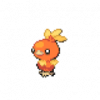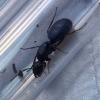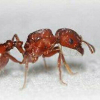- Formiculture.com
- Forums
- Gallery
- Members
- Member Map
- Chat

Nice post and nice looking setup. I am also thinking about lighting and heating for my small setup (20x20x10 arena) and your post is touching exactly the topics I have been thinking.
I do agree with your general points like: "I think the heat comes to the ants in most natural manner, as it's coming in form of infrared radiation - it heats the ant body from the top just like Sun would." and about heat mats: "in my opinion it would be comparable to walking on hot rocks in the evening rather than scorching midday sun, since all of the heat would be coming from the bottom, and light would not bring any heat.".
But it seems to me it is quite hard to optimize everything (heat output, color/CRI, light intensity, automation for imitating the day) just with a single source (like a halogen lamp). I guess that is the reason why the light and heat source is addressed separately. I wonder what others are thinking.
To me the issue of optimization is fairly simple, because I just assumed that not hitting the levels of lux of sunlight is not crucial, and I focused primarily on getting the soil surface to satisfactory temperature. Perhaps I am wrong - but my results with Cataglyphis are satisfying me. I would love two cents from other desert species and genera keepers, what do they think about light intensity - is it important to hit the daylight levels or is it enough to just provide some light to trigger the diurnality of such ants. For reference, according to data from manufacturer of the bulb I am using the outworld is getting somewhere between 6000 and 10000 lux, whereas daylight is about 20000 lux and direct sunlight can be up to 120000 lux. My previous remark about hitting 1/5 of sunlight lux was based on data from a different source, this time I took values from wikipedia. So yeah, far from the most eye-gouging intensity the Sun can produce. If I found this was an issue I would attempt providing extra light with LEDs or changing the concept altogether. I also like the fact the setups are not iluminating my room on cloudy days with strength of a literal star, with a hundred thousand lux it would probably be painful to just look at the soil.
I was initially thinking about a way to simulate mornings and evenings with a truncated sine wave or just a ramp up and ramp down control, but I dropped the concept as it was too complex to implement (since relation between applied voltage and resulting radiation is highly nonlinear) and would probably shorten lifespan of the bulbs (halogen can't be operated too cold or else halogen-tungsten cycle won't occur). This perhaps would be easier to simulate using a heating mat and light like LED, since relation of power and voltage in a resistor is far less complicated and simple conduction heaters don't degrade due to on/off or lower voltage control.
Hitting good CRI with halogen comes naturally, since CRI is an index practically based on incandescent lamps, so halogen gets a 100 score by the very definition. The CRI is specified for a light temperature, though, so hitting 100 CRI at 3000 K does not mean having same color rendition as in the sunlight.
I understand, it is a pretty good solution, also good looking.
I wonder if the heating mat/cable can be preferred because it can be installed on a corner/edge and there will be a natural temperature gradient. With a heat source above, this is probably harder to do, even if the source is not exactly in the center, I guess the gradient on the soil will be less pronounced.
As I have a small arena, I tried using a 10W cement resistor with 12V (at just under 2W) and it heats up to ~70C and starts heating the arena when mounted just at the top of the arena (10cm in my case). Because it is small, and it does not change the light, I can put it pretty close so it is I think more effective than using a lamp above. I did not measure the soil temperature but I guess soil temperature follows. I am considering to use something like this first before using a lamp or heating mat/cable.
Placing a hot resistor on the side of an outworld certainly produces a nice gradient, but I am not sure how is it supposed to be natural.
In the meantime I tested a 35 W halogen in place of the 20 W one. Result: soil temperature at 22-23 cm distance reached 53°C, a black probe placed on top of the rock crossed 60°C.
And Cataglyphis nodus were still climbing up the rock.
Unfortunately I feel I can't provide them this insanity due to the fixture becoming alarmingly hot. Inserting the probe just nest to the cables in the back had shown 80°C, that's also the temperature of metal-shelf contact. I am not sure how heat resistant is IKEA furniture, but I'd rather not find out the smoldering temperature empirically.
Edited by Kowal, August 16 2024 - 9:00 AM.
What an incredibly informative and detailed post; thank you for the time you put into making it! I find your setup both very aesthetic as well as functional and natural for all ants, not just desert species. Is the white box in the top right corner the power supply you speak of in your post?
Go to the ant, you sluggard; consider its ways and be wise! It has no commander, no overseer or ruler, yet it stores its provisions in summer and gathers its food at harvest. -Proverbs 6: 6-8
My Ant Shop Here I have PPQ-526 permits to ship ants nationwide
Attention Ant-Keepers in South Dakota! Join the SoDak(Society Of Dakotan Ant Keepers)
Kowal, on 16 Aug 2024 - 5:00 PM, said:
Placing a hot resistor on the side of an outworld certainly produces a nice gradient, but I am not sure how is it supposed to be natural.
Ants_Dakota, on 16 Aug 2024 - 5:34 PM, said:
What an incredibly informative and detailed post; thank you for the time you put into making it! I find your setup both very aesthetic as well as functional and natural for all ants, not just desert species. Is the white box in the top right corner the power supply you speak of in your post?
Yes. There are special circuit designed for halogen lamps, but you can also use a standard 12 V DC power supply too. The specialised circuits are, comperatively, rather primitive, so you can get a power supply of right power rating cheaper than the standard wall wart. The halogen power supplies do not provide a clean DC output - quite the contrary, they provide very noisy voltage which averages to about 12 V (usually 11,5 V). It works, since the filament does not change temperature significantly between pulses. The pulses are still modulated by mains frequency and that creates a slight beat of the brightness, impossible to notice with naked eye but my camera picks it up while taking a video, so if you want to take many videos then I recommend either matching FPS to mains frequency (easier done in the US) or using a DC power supply.
mete, on 16 Aug 2024 - 6:48 PM, said:
Kowal, on 16 Aug 2024 - 5:00 PM, said:
Placing a hot resistor on the side of an outworld certainly produces a nice gradient, but I am not sure how is it supposed to be natural.
Side mount gives a temp gradient like a heat mat, but I meant mounting on top, not side. So not very different than having a lamp on top, just with no light and more close to the sand surface. However side mount might be better due to the gradient, provides more options to ants I guess.
Ah, so you're just making your own black body radiator ![]() Some heat probably comes through convection, too. I bet you'd get more result if you'd hang a 2 W incandescent bulb above the outworld, especially with any form of reflector. My first reflector for a dichroic coated bulb was just a piece of metal sheet.
Some heat probably comes through convection, too. I bet you'd get more result if you'd hang a 2 W incandescent bulb above the outworld, especially with any form of reflector. My first reflector for a dichroic coated bulb was just a piece of metal sheet.
Edited by Kowal, August 17 2024 - 11:33 PM.
Edited by Mushu, September 5 2024 - 1:54 PM.
You're right about the temperature gradient inside the soil and the fact of surface being the hottest, as it is the sunlight collector. Just 50 cm below the soil surface the temperature is greatly stabilised and does not show much daily variation, allowing the ants to adapt to this resting temperature. I would disagree on the rock being a place my ants are looking for a thermal refuge, solid rocks get as hot as the sand around it in nature, the thermal refuges ants take in nature are points with low surface area elevated above the large surface area of the desert - like grass stems, or, like in one of the documentaries, even a leg of a dead beetle. The temperature gradients are drastic near the surface, elevating their bodies just 1 cm off the ground makes a significant difference.
In captivity it would be hard to reproduce the effect of endless desert with evenly heated surface, in my setups ants have plenty of area without direct halogen light. I reckon that is why they could forage in 60°C - they had place to run to to cool down. Studies about their temperature resistance are done by placing the ants in a temperature controlled container and monitoring deaths after 10 minutes, so no way of them escaping the heat at will. They surely can survive short bursts of higher temperature if they can run off once they realise their body temperature is climbing dangerously high.
I made a journal for one of my two Cataglyphis colonies. Frankly speaking, I should do one for the other colony too, but just didn't find the time to do so.
https://www.formicul...is-rosenhaueri/
What would be your recommendation for a heating setup that is not as hot, but still has aspects of natural light? I really want to build something like you, but I also don't want to fry my ants, especially because I keep them in closed containers (with mesh covered holes for air).
Go to the ant, you sluggard; consider its ways and be wise! It has no commander, no overseer or ruler, yet it stores its provisions in summer and gathers its food at harvest. -Proverbs 6: 6-8
My Ant Shop Here I have PPQ-526 permits to ship ants nationwide
Attention Ant-Keepers in South Dakota! Join the SoDak(Society Of Dakotan Ant Keepers)
Ants_Dakota, on 10 Sept 2024 - 01:11 AM, said:
What would be your recommendation for a heating setup that is not as hot, but still has aspects of natural light? I really want to build something like you, but I also don't want to fry my ants, especially because I keep them in closed containers (with mesh covered holes for air).
There are lower power halogen bulbs, although I have seen only 10 W with built in reflector, and 5 W in form of just the bulb (you need to buy a fixture with a reflector for that). You can modify the temperature by distance from the outworld, and in case of the naked bulbs without reflectors, also by shaping your own reflector, although this might not be a good idea unless you're confident in your DIY skills. If even a 5 W halogen will be too strong, then you can step down to a regular incandescent bulb - these come with powers as low as 1 W and due to lower filament temperature they emit less heat than a 1 W halogen would. Without a reflector it would barely heat the outworld even hanging 5 cm above it, I suppose. I might check it one day - I have some 1 W bulbs somewhere.
I took a video showing morning behaviour of my Cataglyphis rosenhaueri. They pour out of the nest in large numbers in the mornings, by the evening outworld becomes rather empty, even when the bulb is still shining. I think they have an internal timer which tells them that evening is coming, time to hide before competitor ant species emerge. I think no statistical analysis is needed to say they tend to run in the "sunny" part rather than unlit part of the outworld. The test is a bit biased since the nest entrance is within the hot spot, but not in the middle of it, and they concentrate in the hot area rather than around the entrance.
Edited by Kowal, September 12 2024 - 11:58 AM.
 |
Ant Keeping →
General Ant Keeping →
How to Professionally Heat my Ants?Started by Entomologyants , Mar 25 2025 |
|

|
|
 |
Ant Keeping →
General Ant Keeping →
What do I use for heating?Started by RainbowtheDragonCat , Mar 13 2025 |
|

|
|
 |
Anting →
General Anting →
Conditions for Desert Flights: A look into thunderstormsStarted by UtahAnts , Aug 4 2024 |
|

|
|
Ant Keeping →
Ant Keeping Journals →
Dusty's Veromessor Pergandei Colony (my first time!)Started by DustyDoes , Apr 11 2022 |
|

|
||
Market Place →
General Market Place →
MM's Cali-AntsStarted by MillyMoney , Sep 15 2020 |
|

|
0 members, 2 guests, 0 anonymous users